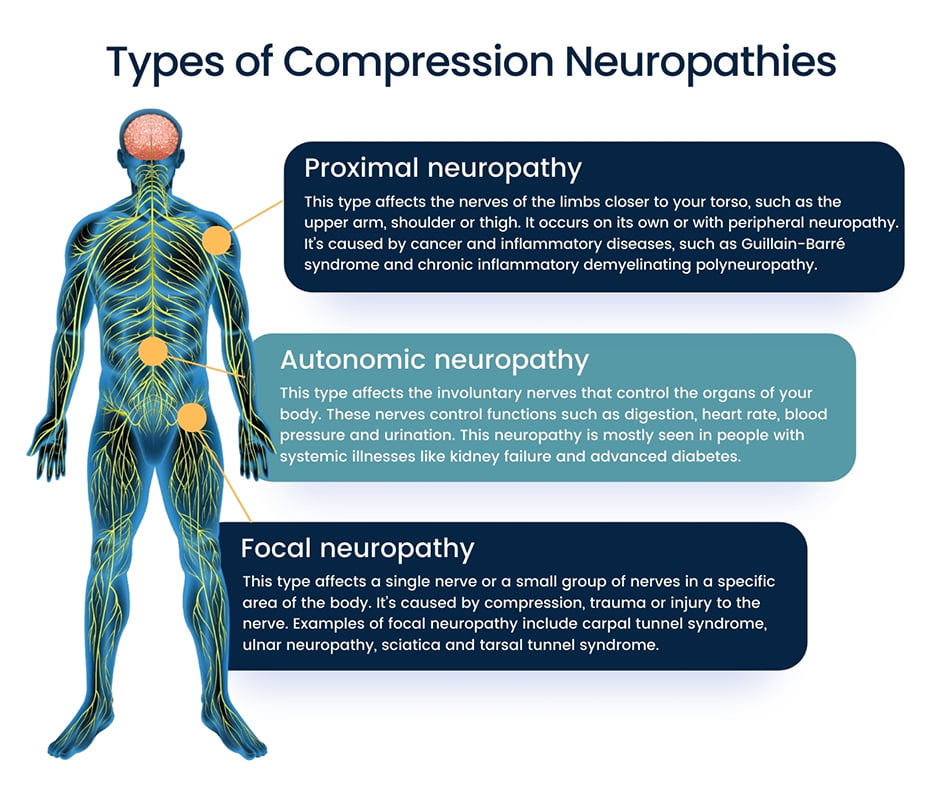Compression neuropathy treatment may be as simple as directing you to stop doing the movements that pinch the nerves until they cause you pain. Other times, you need compression neuropathy treatment that’s a bit more invasive, such as a surgical procedure to release the pressure on a damaged nerve. For the best compression neuropathy treatment in New York City, call the experts at Pain Management NYC today for a consultation.
What Is Compression Neuropathy?
Compression neuropathy is a condition caused when a nerve is compressed or squeezed by surrounding tissues. It causes pain, numbness, tingling or weakness in the affected area. It occurs in different parts of your body, such as the wrist, elbow, shoulder, thigh or foot. If left untreated, compression neuropathy leads to permanent nerve damage and disability.
At Pain Management NYC, a team of board-certified specialists offer compression neuropathy treatment, as well as treatments for other neurological disorders. These experts use the latest techniques and technologies to offer a comprehensive range of services, including medication, physical and occupational therapy, and minimally invasive surgery. They also provide personalized care and education to alleviate the effects of neuropathy.
What Are the Common Types of Compression Neuropathy?
Different types of compression neuropathy affect different nerves in the body, usually with a specific pattern of involvement. Peripheral neuropathy is a type that affects the nerves that control the movement and sensation of your limbs. It often affects the hands and feet more severely than other areas of the body.
Sometimes, you can develop more than one type of compression neuropathy.
Other types of compression neuropathies include:
- Autonomic neuropathy. This type affects the involuntary nerves that control the organs of your body. These nerves control functions such as digestion, heart rate, blood pressure and urination. This neuropathy is mostly seen in people with systemic illnesses like kidney failure and advanced diabetes.
- Proximal neuropathy. This type affects the nerves of the limbs closer to your torso, such as the upper arm, shoulder or thigh. It occurs on its own or with peripheral neuropathy. It’s caused by cancer and inflammatory diseases, such as Guillain-Barré syndrome and chronic inflammatory demyelinating polyneuropathy.
- Focal neuropathy. This type affects a single nerve or a small group of nerves in a specific area of the body. It’s caused by compression, trauma or injury to the nerve. Examples of focal neuropathy include carpal tunnel syndrome, ulnar neuropathy, sciatica and tarsal tunnel syndrome.

What Are the Options for Compression Neuropathy Treatment?
Pain Management NYC offers different treatments for compression neuropathy based on the latest techniques available in medicine today. They also look at your condition comprehensively to treat the underlying causes. They evaluate your condition and recommend the best compression neuropathy treatment plan for you.
The treatment for compression neuropathy depends on the cause, severity and location of the nerve compression as well as treatment for the underlying condition that may be causing the nerve damage. The goal of treatment is to relieve the pressure on the nerve and restore its function.
Common treatments for compression neuropathy include:
- Splinting and bracing. Wearing a splint or brace immobilizes the affected joint and prevents further nerve damage.
- Medications. Nonsteroidal anti-inflammatory drugs and steroid injections reduce pain and inflammation in the nerve.
- Physical and occupational therapy. Exercises and stretches improve the strength and flexibility of the muscles and tendons around the nerve and help the nerve glide more freely.
- Injections of corticosteroids to decrease inflammation and relieve compression-related discomfort
- Surgery. Surgery is usually considered as a last resort for compression neuropathy when other treatments have failed to provide adequate relief or when the nerve damage is severe or progressive. Surgery aims to decompress the nerve by removing or releasing the structures causing the pressure, such as tumors, cysts, bone spurs or ligaments. Surgery also repairs the nerve by reconnecting the ends of the nerve directly, using a graft from another nerve, or performing a nerve transfer from a nearby nerve.
What Are the Causes of Compression Neuropathy?
Compression neuropathy comes about when a nerve is squeezed by surrounding tissue and bones. This pressure damages the nerve and interferes with its function. Compression neuropathy affects different nerves in different parts of the body, depending on the location and cause of the compression.
One of the top causes of compression neuropathy is repetitive motions or activities that put stress on the nerve, such as typing, playing an instrument, on the job or from playing a sport.
Other common causes for this disorder include:
- Injuries or trauma that cause swelling, bleeding or displacement of the tissues around the nerve, such as sprains, fractures or dislocations
- Medical conditions that affect the nerves or the blood vessels that supply them, such as diabetes, arthritis, hypothyroidism or autoimmune diseases
- Anatomical variations or abnormalities that narrow the space for the nerve to pass through, such as bone spurs, cysts or tumors
What Are the Symptoms of Compression Neuropathy?
Symptoms you need compression neuropathy treatment vary depending on the nerve and the location of the compression. They usually start gradually and worsen over time. They may also come and go or change with certain activities or positions.
If you experience any of the symptoms, you should seek medical attention as soon as possible. Early diagnosis and treatment prevent further nerve damage and improve your outcome.
Some of the common symptoms of compression neuropathy include:
- Pain, burning or aching in the affected area
- Numbness, tingling or pins and needles sensations
- Muscle weakness, cramps or spasms
- Difficulty moving or controlling the affected limb or joint
- Loss of sensation or coordination
- Changes in skin color, temperature or texture
What Are the Long-Term Complications of Compression Neuropathy?
Compression neuropathy has serious and lasting consequences if not treated promptly and properly. The most serious long-term effect is permanent nerve damage and loss of function. Severe or prolonged nerve compression causes irreversible damage to the nerve fibers and affects their ability to transmit signals.
This permanent damage results in chronic pain, numbness, weakness or paralysis of the affected limb or organ.
Other possible complications of compression neuropathy include:
- Muscle atrophy and contractures. Nerve damage also affects the muscles that are innervated by the compressed nerve. The muscles lose their mass and strength and become stiff and shortened. This limits the range of motion and mobility of the affected joint.
- Foot ulcers and infections. Nerve damage in the feet impair the sensation and blood circulation of the skin. This makes the feet more prone to injuries, blisters and sores that may not heal well. If these wounds become infected, it can lead to gangrene and amputation in severe cases.
- Cardiovascular problems. Nerve damage in the autonomic nervous system affects the regulation of the heart and blood vessels. This causes problems such as low blood pressure, irregular heartbeat and fainting.
Pain Management NYC has the expertise and experience to diagnose and treat your compression neuropathy using the best available options. Whether you need medication, therapy or surgery, they provide you with personalized and effective care. Don’t let compression neuropathy ruin your way of life. Contact Pain Management NYC today to book your appointment and start compression neuropathy treatment.

Boleslav Kosharskyy, MD, is a top-rated, best-in-class interventional pain management doctor. He is board-certified in Anesthesiology, Interventional Pain Medicine, and Palliative Care.
Dr. Kosharskyy is an Associate Professor of Anesthesiology and Rehabilitation Medicine at Albert Einstein Medical College. He’s also the Associate Medical Director of Pain Medicine and Director of Anesthesia for the Joint Replacement Center at Montefiore Medical Center and Albert Einstein Medical College.
He is an active member of the American Society of Anesthesiology (ASA), the American Society of Regional Anesthesia and Pain Medicine (ASRA), and the New York State Society of Anesthesiologists (NYSSA)
